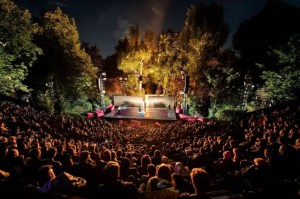Year of the Producer: Emma Stenning on reopening Bristol Old Vic
Emma Stenning is executive director of the Bristol Old Vic, where, alongside artistic director Tom Morris she has been in post since 2009.
directors of London’s Battersea Arts Centre where, amongst other
successes, they provided a launching pad for Jerry Springer – The Opera.
Under their stewardship the Bristol Old Vic, which celebrates its 250th anniversary in 2016, has undergone comprehensive refurbishment. Impressively, it has continued to run a full programme while the theatre has been closed, including a revival of Coram Boy in the Colston Hall.
The Grade I Listed Georgian auditorium officially reopens to the public today (11 September 2012) with new production of John O’Keeffe’s classic comedy Wild Oats.
Here, as part of our ongoing Year of the Producer series, in assocation with 2012 Whatsonstage.com Awards adopted charity Stage One, Stenning tells us what we can expect from the new-look Bristol Old Vic…
Emma Stenning: For the audience member, the major thing you’ll notice in the new auditorium is the new seats; they’re now unbelievably comfortable and the sight lights are brilliant. So in a sense I’d say that’s £12million quid well spent already! But what you won’t see is the infrastructure upgrade that’s gone into the building – the mechanics and the engineering, and most vitally the fire warning and fire protection systems. Given that Bristol Old Vic is an improbable miracle against the destruction of fire, it felt vital to do that.

If you’re an artist coming to work at the Bristol Old Vic you’ll find two of the most exceptional new rehearsal studios in the country, to rival the splendid Jerwood Space in London. They’re beautiful and light and you can rig lighting and fly people and do all sorts of magic in there. In a sense I think that’s one of the most vital parts of the development. There are also fabulous new dressing rooms and offices for the staff.
But it’s actually our next phase of development that will be most noticeable. It will transform the front of house and social spaces of the theatre, but people who are coming to visit in the meantime will need to forgive us a slightly shabby front of house and know that our aim is to complete the full refurbishment by 2016. You’ll probably have to come in through the back door and you’ll probably find a bar that’s in one of our workshop spaces rather than in front of house, but in our experience people quite like an adventure.
Working on a listed building
It’s a complete nightmare! To say it’s been a learning curve is a massive understatement. I’d never before even had decorators into my own kitchen and here we are in the process of spending 20 odd million on refurbishing a listed building. The lesson is that you should surround yourself with the best advice and the best consultation you can get and then prioritise and protect the things you know are right for the organisation. For us that’s been the aesthetics of the theatre space, which is to return to the original Georgian playing dimensions of the space. We’ve put back the Georgian forestage so there will be very particular playing dynamics in the theatre which are unique to Bristol Old Vic.
It was certainly Tom’s strong instinct that this was the right thing to do so I guess you learn to listen to your own judgements about what’s right creatively for the space, even they’re nonsensical to people in the building trade. You have to learn in the face of people who are citing a much more pragmatic argument that you should just cling to the thing that you know is right. You move forward and try and inspire people’s confidence in what you’re doing and you just take it at your own pace. I’m sure we’ll have another four years of challenge around the building but I know that we can do it now.
Funding
We have a really good relationship with the Arts Council and they are committed to funding Bristol Old Vic. We’re one of the big 11 theatres. We have an annual grant of about £1.3 million, and we’re obviously delighted to start a year of planning with that kind of cheque coming into the accounts. There aren’t many theatres in the world that can rely on that and we’re forever thankful for it. On the other hand we are the 11th worst funded of the big eleven, and now is the test. For the last three years we’ve been operating a sporadic programme of work and we’re about to reopen our main space and begin producing pretty much consistently. We’re planning to turn around production after production and to tour that work nationally and internationally, so the question will become about whether that level of subsidy affords the ambition of the organisation?
It’s difficult and what I’m hoping is that, as we finally start to demonstrate a Bristol Old Vic at full strength creatively and operationally, the Arts Council will stay with us and make an investment in the building that enables us to really capitalise on its opportunity. But I can appreciate from their point of view it’s been quite a turnaround story because four years ago who would have dreamt that we’d be where we are now? I think it’ll take some time to pluck up the courage.
Plans for the future
I absolutely love it here so for the time being it’s difficult to imagine anything else. By and large I get to run the most amazing theatre with my favourite artist and for someone that does my job it doesn’t really get a lot better than that.
I’ve also realised that I’m someone who really thrives in a rapidly changing environment. I like to solve a big problem, and the kind of story that we’ve had here is exactly where I’m meant to be. You have moments when you think ‘oh maybe I’ll just run one of those theatres where nothing goes wrong’, but I don’t think I’m suited to that at all. I feel tremendous commitment and loyalty and hunger to stay here until this place is truly solvent, financially protected, thriving, and the building is finished.
I’m sure once we’ve done that we’d like a little bit of time to show off in our theatre but then it’ll be time to sniff out the next challenge.
– Emma Stenning was speaking to Theo Bosanquet












